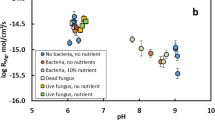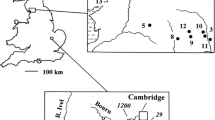Abstract
Geochemical variations induced by the interaction of fungus and calcite were studied. The results showed that the fungal metabolic activities could accelerate the calcite dissolution rate, and dissolution continued even when the solution was supersaturated with respect to calcite. The calcite dissolution rate was also influenced by solution chemistry, such as pH and the concentration of \( {\text{HCO}}_{3}^{ - } \). Based on these results, the importance of fungal activity in the formation of karst geomorphology was discussed.


Similar content being viewed by others
References
Ascaso C, Wierzchos J, Castello R (1998) Study of the biogenic weathering of calcareous litharenite stones caused by lichen and endolithic microorganisms. Int Biodeterior Biodegradation 42:29–38
Burford EP, Fomina M, Gadd GM (2003a) Fungal involvement in bioweathering and biotransformation of rocks and minerals. Mineral Mag 67:1127–1155
Burford EP, Kierans M, Gadd GM (2003b) Geomycology: fungi in mineral substrata. Mycologist 17:98–107
Caldeira K, Rau GH (2000) Accelerating carbonate dissolution to sequester carbon dioxide in the ocean: geochemical implications. Geophys Res Lett 27:225–228
Drever JI, Stillings LL (1997) The role of organic acids in mineral weathering. Colloids Surf A 120:167–181
Ford DC, Williams PW (2007) Karst hydrogeology and geomorphology. Wiley, New Jersey
Golubic S, Schneider J (1979) Carbonate dissolution. Biogeochemical cycling of mineral-forming elements. Elsevier Scientific Publishing Company, New York
Hoffland E, Kuyper TW, Wallander H, Plassard C, Gorbushina AA, Haselwandter K, Holmstrm S, Landeweert R, Lundstrm US, Rosling A (2004) The role of fungi in weathering. Front Ecol Environ 2:258–264
Hose LD, Palmer AN, Palmer MV, Northup DE, Boston PJ, DuChene HR (2000) Microbiology and geochemistry in a hydrogen-sulphide-rich karst environment. Chem Geol 169:399–423
Hou W, Lian B, Zhang X (2011) CO2 mineralization induced by fungal nitrate assimilation. Bioresour Technol 102(22):1562–1566
Landeweert R, Hoffland E, Finlay RD, Kuyper TW, van Breemen N (2001) Linking plants to rocks: ectomycorrhizal fungi mobilize nutrients from minerals. Trends Ecol Evol 16:248–254
Larone DH (2002) Medically important fungi: a guide to identification. ASM Press, Washington
Li Q, Sun H, Han J, Liu Z, Yu L (2008) High-resolution study on the hydrochemical variations caused by the dilution of precipitation in the epikarst spring: an example spring of Landiantang at Nongla, Mashan, China. Environ Geol 54:347–354
Li W, Zhou PP, Jia LP, Yu LJ, Li XL, Zhu M (2009) Limestone dissolution induced by fungal mycelia, acidic materials, and carbonic anhydrase from fungi. Mycopathologia 167:37–46
Lian B, Wang B, Pan M, Liu C, Teng HH (2008) Microbial release of potassium from K-bearing minerals by thermophilic fungus Aspergillus fumigatus. Geochim Cosmochim Acta 72:87–98
Liu Z (2001) Role of carbonic anhydrase as an activator in carbonate rock dissolution and its implication for atmospheric CO2 sink. Acta Geologica Sinica (English Edition) 75:275–278
Liu Z, Groves C, Yuan D, Meiman J, Jiang G, He S, Li Q (2004) Hydrochemical variations during flood pulses in the south-west China peak cluster karst: impacts of CaCO3–H2O–CO2 interactions. Hydrol Process 18:2423–2437
Lyalikova NN, Petushkova YP (1991) Role of microorganisms in the weathering of minerals in building stone of historical buildings. Geomicrobiol J 9:91–101
Macpherson GL, Roberts JA, Blair JM, Townsend MA, Fowle DA, Beisner KR (2008) Increasing shallow groundwater CO2 and limestone weathering, Konza Prairie, USA. Geochim Cosmochim Acta 72:5581–5599
Marsh JM, Lloyd JW (1980) Details of hydrochemical variations in flowing wells. Ground Water 18:366–373
Masaphy S, Zabari L, Pastrana J, Dultz S (2009) Role of fungal mycelium in the formation of carbonate concretions in growing media—an investigation by SEM and synchrotron-based X-ray tomographic microscopy. Geomicrobiol J 26:442–450
Millero FJ (1995) Thermodynamics of the carbon dioxide system in the oceans. Geochim Cosmochim Acta 59:661–667
Northup DE, Lavoie KH (2001) Geomicrobiology of caves: a review. Geomicrobiol J 18:199–222
Pitzurra L, Moroni B, Nocentini A, Sbaraglia G, Poli G, Bistoni F (2003) Microbial growth and air pollution in carbonate rock weathering. Int Biodeterior Biodegradation 52:63–68
Plummer LN, Busenberg E (1982) The solubilities of calcite, aragonite and vaterite in CO2–H2O solutions between 0 °C and 90 °C, and an evaluation of the aqueous model for the system CaCO3–CO2–H2O. Geochim Cosmochim Acta 46:1011–1040
Shotwell O, Hesseltine C, Stubblefield R, Sorenson W (1966) Production of aflatoxin on rice. Appl Environ Microbiol 14:425–428
Viles HA (1988) Cyanobacterial and other biological influences on terrestrial limestone weathering on Aldabra: implications for landform development. Bull Biol Soc Wash 8:5–13
Wigley TML (1977) WATSPEC: a computer program for determining the equilibrium speciation of aqueous solutions. Br Geomorphol Res Group Tech Bull 20:48
Acknowledgments
This study was financially supported by the National Natural Science Foundation of China (40773069), the Ministry of Science and Technology of China (2006CB403200), and the National Science Fund for Creative Research Groups (40721002).
Author information
Authors and Affiliations
Corresponding authors
Rights and permissions
About this article
Cite this article
Hou, W., Dou, C., Lian, B. et al. The interaction of fungus with calcite and the effects on aqueous Geochemistry in karst systems. Carbonates Evaporites 28, 413–418 (2013). https://doi.org/10.1007/s13146-013-0136-7
Accepted:
Published:
Issue Date:
DOI: https://doi.org/10.1007/s13146-013-0136-7




